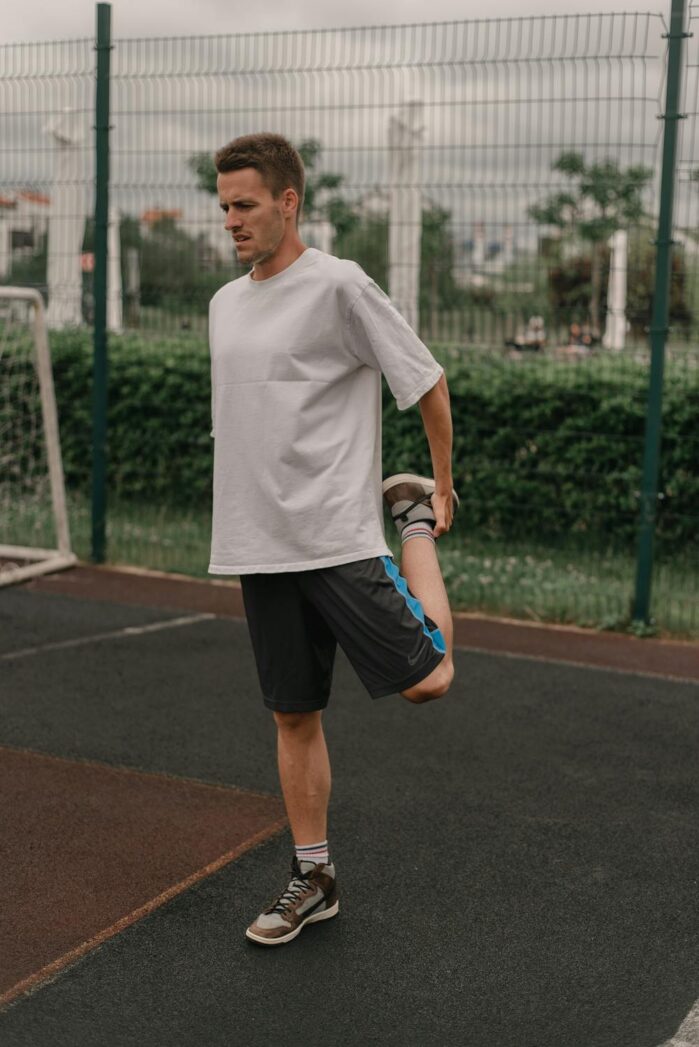
Low-impact exercises like swimming, cycling, and walking can help people with knee pain lose weight. Strength training and yoga are also beneficial.
Weight loss can be challenging for individuals with knee pain, but low-impact exercises make it achievable. Swimming offers a full-body workout without stressing the knees. Cycling, either on a stationary bike or outdoors, strengthens leg muscles while being gentle on the joints.
Walking is a simple yet effective exercise that can be adjusted for intensity. Strength training helps build muscle, which increases metabolism and supports knee stability. Yoga enhances flexibility, reduces stress, and promotes overall well-being. Combining these exercises helps achieve weight loss goals while minimizing knee pain. Always consult a healthcare provider before starting any new exercise regimen.
Gentle Cardio Options
Weight loss can be challenging for those with knee pain. Gentle cardio options can help you stay active without putting too much strain on your knees. These exercises are low-impact, making them ideal for people with joint issues. Let’s explore some effective options.
Walking Techniques
Walking is a fantastic exercise for people with knee pain. It is low-impact and can be done almost anywhere. Here are some tips to make your walking routine more effective:
- Wear supportive shoes: Proper footwear can reduce knee stress.
- Warm-up: Always start with a warm-up to prepare your muscles.
- Maintain good posture: Keep your back straight and your shoulders relaxed.
- Pace yourself: Start slow and gradually increase your speed.
- Use a walking aid: If necessary, use a cane or walking stick.
Walking on different surfaces can also impact knee pain. Consider these surface types:
| Surface Type | Impact on Knees |
|---|---|
| Grass | Soft and reduces impact |
| Treadmill | Offers consistent surface and cushioning |
| Concrete | Hard and can increase knee stress |
Interval walking can boost your weight loss efforts. Alternate between walking at a moderate pace and a brisk pace. This technique increases your heart rate and burns more calories.
Swimming Benefits
Swimming is another excellent option for those with knee pain. It provides a full-body workout without stressing the joints. Here are some key benefits of swimming:
- Low-impact exercise: The water supports your body, reducing joint strain.
- Increases flexibility: Swimming movements can improve joint flexibility.
- Builds muscle strength: Water resistance helps strengthen muscles.
- Improves cardiovascular health: Swimming boosts heart and lung function.
Different swimming strokes can target various muscle groups. Consider these strokes:
| Stroke Type | Muscle Groups Targeted |
|---|---|
| Freestyle | Arms, shoulders, and core |
| Breaststroke | Chest, triceps, and legs |
| Backstroke | Back, shoulders, and legs |
Water aerobics is another great alternative. These classes offer structured workouts that are easy on the knees. The buoyancy of water provides support, making movements smoother and less painful.
Strength Training Essentials
Losing weight can be challenging, especially for those with knee pain. Engaging in high-impact exercises often worsens the pain. Strength training is essential for weight loss without stressing your knees. It helps build muscle, improves metabolism, and supports joint health. Here, we’ll explore some effective strength training exercises, focusing on seated exercises and resistance bands.
Seated Exercises
Seated exercises are great for those with knee pain. They allow you to strengthen muscles without putting pressure on your knees. Here are some seated exercises to consider:
- Seated Leg Lifts: Sit on a chair with your back straight. Lift one leg and hold for a few seconds, then lower it. Repeat with the other leg. This exercise targets your quadriceps.
- Seated March: Sit straight on a chair. Lift one knee towards your chest, then lower it. Repeat with the other knee. This helps improve hip flexor strength.
- Seated Knee Extensions: Sit on a chair and extend one leg straight out. Hold for a few seconds, then lower. Repeat with the other leg. This strengthens your thigh muscles.
Including a variety of seated exercises can help you target different muscle groups while avoiding knee pain. These exercises are easy to perform at home and don’t require any special equipment.
Resistance Bands
Resistance bands are versatile tools for strength training. They provide resistance without putting stress on your knees. Here are some effective resistance band exercises:
- Leg Press: Sit on a chair and loop the resistance band around your feet. Push your legs out against the band, then slowly return to the starting position. This exercise strengthens your legs and glutes.
- Seated Row: Sit on the floor with your legs extended. Loop the band around your feet and hold the ends. Pull the band towards your body, squeezing your shoulder blades together, then release. This targets your back muscles.
- Arm Curls: Sit on a chair and step on the middle of the band with your feet. Hold the ends of the band and curl your arms up towards your shoulders, then lower. This exercise works your biceps.
Using resistance bands can help you strengthen various muscle groups without straining your knees. They are portable, affordable, and can be used for a wide range of exercises.
Low-impact Activities
Struggling with knee pain shouldn’t stop you from achieving your weight loss goals. Low-impact activities offer an excellent way to shed pounds without putting too much strain on your knees. These exercises help protect your joints while still providing an effective workout. Let’s explore some fantastic low-impact activities that can get you moving and grooving without the pain.
Cycling Tips
Cycling is a superb low-impact activity for weight loss and knee pain. Riding a bike helps you burn calories and build muscle without stressing your joints. Here are some essential tips to make the most out of cycling:
- Choose the right bike: Opt for a comfortable bike with adjustable seats and handlebars. A well-fitted bike reduces the risk of knee pain.
- Warm-up: Always start with a 5-10 minute warm-up. Gentle pedaling increases blood flow and prepares your muscles.
- Adjust your seat height: Your seat should be at a height where your knee is slightly bent at the bottom of the pedal stroke. This position minimizes knee strain.
- Use low resistance: Avoid high gears. Pedaling with lower resistance is easier on your knees and still effective for weight loss.
- Gradually increase intensity: Start slow and gradually increase the intensity of your workouts. This approach helps you avoid injury.
Here’s a simple table for a weekly cycling plan:
| Day | Duration | Intensity |
|---|---|---|
| Monday | 30 minutes | Low |
| Wednesday | 45 minutes | Moderate |
| Friday | 30 minutes | Low |
| Sunday | 60 minutes | Moderate |
Elliptical Machines
Elliptical machines offer an excellent low-impact workout. They combine the benefits of walking, running, and climbing stairs without the harsh impact on your knees. Here’s how to make the most of an elliptical workout:
- Correct posture: Stand upright and keep your core engaged. Good posture helps you avoid knee pain and other injuries.
- Adjust resistance: Start with a low resistance level. Gradually increase it to challenge yourself while avoiding strain.
- Use the handlebars: Move your arms along with your legs. This full-body movement burns more calories and provides a balanced workout.
- Monitor your speed: Maintain a steady pace. Speeding up too quickly can put unnecessary pressure on your knees.
- Mix up your routine: Vary your workouts by adjusting the incline and resistance. This variety keeps your muscles guessing and maximizes weight loss.
Here’s an example of a weekly elliptical workout plan:
| Day | Duration | Intensity |
|---|---|---|
| Tuesday | 20 minutes | Low |
| Thursday | 30 minutes | Moderate |
| Saturday | 45 minutes | Low |
| Sunday | 30 minutes | Moderate |

Credit: www.wikihow.com
Flexibility And Stretching
Weight loss exercises for people with knee pain need special attention. Flexibility and stretching play a crucial role. They help in reducing stiffness and improving the range of motion. Regular stretching keeps the joints flexible and reduces the risk of injury. Let’s explore some effective stretching exercises for those with knee pain.
Simple Stretches
Simple stretches can be done anywhere, anytime. They are crucial for those with knee pain. Here are some easy stretches:
- Hamstring Stretch: Sit on the floor with one leg straight and the other bent. Reach forward towards the toes of the straight leg. Hold for 20 seconds.
- Quadriceps Stretch: Stand on one leg and pull the other foot towards your buttock. Hold onto a chair for balance if needed. Hold for 20 seconds.
- Calf Stretch: Stand facing a wall. Place one foot forward and the other back. Bend the front knee and keep the back leg straight. Press the heel into the ground. Hold for 20 seconds.
These stretches can be repeated 2-3 times daily. They help in loosening tight muscles around the knee, reducing pain, and improving flexibility.
Yoga Poses
Yoga poses are gentle on the knees and help in improving flexibility. Here are some beneficial yoga poses:
- Child’s Pose: Kneel on the floor, sit back on your heels and stretch your arms forward. Hold for 30 seconds.
- Cat-Cow Pose: Get on your hands and knees. Alternate between arching your back (cat) and dipping it (cow). Repeat 10 times.
- Downward-Facing Dog: From a hands-and-knees position, lift your hips up to form an inverted V. Hold for 30 seconds.
Yoga poses can be performed daily. They enhance joint flexibility and relieve knee pain. Always move slowly and avoid straining the knee.
Balance And Stability Workouts
Struggling with knee pain but still want to lose weight? Balance and stability workouts can be a game-changer. These exercises help you stay fit without putting too much stress on your knees. They improve your overall balance, making everyday tasks easier and safer. Let’s explore some effective workouts.
Tai Chi Benefits
Tai Chi is a gentle form of exercise that originated in China. It involves slow, deliberate movements and deep breathing. This low-impact workout is perfect for people with knee pain. Here are some key benefits:
- Improves Balance: Regular practice enhances your balance, reducing the risk of falls.
- Increases Flexibility: Helps in stretching and loosening tight muscles around your knees.
- Reduces Stress: The meditative aspect lowers stress levels, improving mental health.
- Strengthens Muscles: Builds strength in your legs without putting too much pressure on the knees.
According to a study published in the Journal of Rheumatology, Tai Chi is effective in reducing knee pain in older adults. The study showed significant improvement in pain management and physical function after 12 weeks of practice.
| Benefits | Description |
|---|---|
| Balance | Helps you stay steady on your feet |
| Flexibility | Increases the range of motion in your joints |
| Stress Reduction | Lowers anxiety and improves mood |
| Muscle Strength | Builds leg muscles with low-impact movements |
Balance Boards
Using a balance board can be an excellent way to improve stability while losing weight. These boards challenge your core and leg muscles, enhancing your overall balance. Here are some benefits:
- Engages Core Muscles: Helps in strengthening your core, which supports your knees.
- Improves Coordination: Boosts your ability to coordinate movements.
- Low-Impact Exercise: Provides a safe way to exercise without straining your knees.
- Enhances Proprioception: Improves your body’s sense of position and movement.
Balance boards come in various types, such as wobble boards, rocker boards, and roller boards. Each type offers unique benefits:
| Type | Benefits |
|---|---|
| Wobble Board | 360-degree movement for overall balance |
| Rocker Board | Back-and-forth movement for focused stability |
| Roller Board | Challenging balance through rolling motion |
Start with short sessions and gradually increase the duration as your balance improves. Always ensure you’re using the board on a flat, non-slip surface to prevent accidents.
Incorporating Daily Movements
Exercise is crucial for weight loss, but knee pain can make it challenging. Incorporating daily movements can ease this struggle. Simple activities throughout the day can burn calories and strengthen muscles without causing knee discomfort.
Household Tasks
Household tasks provide a great way to stay active. Many chores can help burn calories and improve fitness. Here are some examples:
- Vacuuming: Vacuuming can engage your core and arm muscles. It burns about 150 calories per hour.
- Dusting: Dusting high and low surfaces can be a gentle stretch for your body.
- Gardening: Planting, weeding, and watering plants can be gentle on the knees. It also burns 200-300 calories per hour.
- Doing Laundry: Carrying laundry baskets and folding clothes can keep you moving and active.
These chores not only keep your home tidy but also contribute to your daily exercise quota. To make it more effective, switch tasks frequently and maintain good posture. Avoid bending your knees too much to prevent strain. Incorporating these tasks into your routine can make a significant difference in your weight loss journey.
Active Commuting
Active commuting is an excellent way to stay fit. It involves using physical activity as a mode of transportation. Here are some knee-friendly options:
- Walking: Walking to nearby places can be a great low-impact exercise. Aim for a brisk pace to increase your heart rate.
- Cycling: Using a bike is gentle on the knees and can be a fun way to commute. Ensure your bike is adjusted properly to avoid strain.
- Public Transport: Walk to and from bus stops or train stations. Take the stairs instead of escalators or elevators.
Active commuting not only helps with weight loss but also reduces your carbon footprint. You can integrate it easily into your daily routine. Start with short distances and gradually increase. Wearing comfortable shoes and carrying a water bottle can make it easier and more enjoyable.
Monitoring Progress
Weight loss exercises can be a challenge for people with knee pain. Monitoring progress becomes essential in ensuring success and avoiding further injury. By keeping track of your improvements, you can stay motivated and adjust your exercises as needed.
Setting Realistic Goals
Setting realistic goals is crucial for anyone dealing with knee pain. Start with small, achievable targets. This prevents discouragement and reduces the risk of overexertion. Consider these steps:
- Consult your doctor: Before beginning any exercise program, get professional advice.
- Focus on low-impact exercises: Swimming, cycling, and walking are great options.
- Set short-term and long-term goals: For instance, aim to walk for 10 minutes daily for the first week. Gradually increase the duration.
Use a table to outline your goals:
| Week | Exercise | Duration |
|---|---|---|
| 1 | Walking | 10 minutes |
| 2 | Walking | 15 minutes |
| 3 | Swimming | 20 minutes |
By setting specific and manageable goals, you can celebrate small victories and stay motivated.
Tracking Improvements
Tracking improvements helps you see progress and stay motivated. Use different methods to monitor your journey:
- Keep a journal: Write down your daily activities, duration, and how you feel.
- Use a fitness app: Apps like MyFitnessPal can help you log exercises and track your weight.
- Take measurements: Measure your waist, hips, and thighs weekly to see changes.
Consider using a table to track your progress:
| Date | Exercise | Duration | Weight | Notes |
|---|---|---|---|---|
| 01/01/2023 | Walking | 10 minutes | 200 lbs | Felt good |
| 01/08/2023 | Walking | 15 minutes | 198 lbs | Knees felt fine |
| 01/15/2023 | Swimming | 20 minutes | 196 lbs | No pain |
Seeing tangible progress can be incredibly motivating. It also helps you identify what works best for your body.

Credit: healthsciences.unimelb.edu.au
Consulting Professionals
Knee pain can make weight loss exercises seem daunting. But with the right approach, you can still stay active and shed pounds. Consulting professionals is crucial for a safe and effective exercise routine. This ensures you avoid aggravating your knee pain while maximizing your weight loss efforts. Below, we explore the roles of physical therapists and personal trainers in helping you achieve your goals.
Physical Therapists
Physical therapists specialize in creating exercise plans tailored to your specific needs. They understand how to work around knee pain and other limitations. Here’s how they can help:
- Assessment: A thorough assessment of your knee condition and overall health.
- Personalized Plan: Customized exercise routines focusing on low-impact activities.
- Monitoring: Regular monitoring to adjust exercises as needed.
- Education: Teaching you how to perform exercises correctly to avoid injury.
Physical therapists can recommend exercises like:
| Exercise | Benefits |
|---|---|
| Swimming | Low-impact, full-body workout |
| Stationary Biking | Strengthens leg muscles without stressing the knees |
| Walking | Improves cardiovascular health and burns calories |
Personal Trainers
Personal trainers can provide additional support for your weight loss journey. They work closely with physical therapists to ensure your exercise plan is effective and safe. Here’s what they offer:
- Motivation: Keeping you motivated and accountable.
- Guidance: Offering guidance on proper form and technique.
- Adaptability: Adjusting exercises to fit your progress and comfort level.
- Variety: Incorporating a variety of exercises to prevent boredom.
Some weight loss exercises a personal trainer might suggest include:
- Resistance Bands: Strengthens muscles without heavy weights.
- Aquatic Aerobics: Offers a fun, low-impact workout.
- Chair Exercises: Allows you to stay active even while seated.
By working with professionals, you can confidently embark on your weight loss journey without worsening your knee pain. They offer the expertise and support needed to achieve your fitness goals safely.
Frequently Asked Questions
What Exercises Are Safe For Knee Pain?
Low-impact exercises like swimming, cycling, and walking are safe. These activities strengthen muscles without stressing the knees.
Can Weight Loss Help With Knee Pain?
Yes, weight loss can reduce pressure on knee joints. It can alleviate pain and improve mobility.
How Often Should I Exercise With Knee Pain?
Aim for at least 3-4 times a week. Consistency helps in managing pain and improving strength.
Are There Specific Stretches For Knee Pain?
Yes, quad and hamstring stretches can help. They improve flexibility and support knee function.
Conclusion
Finding the right weight loss exercises with knee pain is possible. Focus on low-impact activities like swimming, cycling, and yoga. These exercises can help you shed pounds without straining your knees. Always consult with a healthcare professional before starting any new workout routine.
Stay consistent and patient for the best results.









